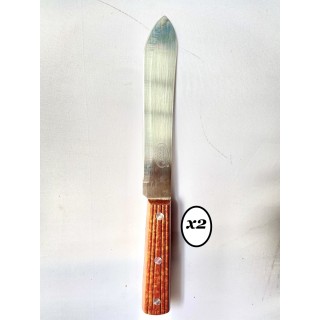- Very sharp
- Durable
- Easy to wash
- Used in every part of the home
Kitchen Knife (x 2pcs)
Availability: In Stock
₦3,000.00
A utensil that has a handle and a blade that may or may not be sharp-edged. Available in a wide variety of different types and sizes, a knife is used for cutting, chopping, dicing, slicing, mincing, peeling, separating, and other kitchen tasks where the thin metal shaft of a blade is of value for food preparation. Special purpose knives such as boning, carving, mincing, slicing, deveining, and paring knives are available as well specific food knives for butter, cheese, chestnuts, clams, filets, grapefruit, oysters, tomatoes, and steak.When selecting a knife the size and type desired is most often determined by the purpose of use. Since many knives are made for a specific purpose, such as chopping, mincing, cutting large items, or other tasks that are well defined, it is best to determine the use and then select one that fits the intended purpose. When selecting a knife, there are eight basic knife parts that are of value to understand which are: 1) tip, 2) cutting edge, 3) spine, 4) heel, 5) bolster, 6) tang, 7) butt, and 8) handle. The tip, which is the pointed end of the blade is most often used for spearing foods or cutting small items such as shallots, garlic, mushrooms, strips of foods, small shellfish, and other similar sized items. The cutting edge of the blade is the bottom side of the blade and it may be straight-edged or serrated, depending on the use. The top side of the blade, opposite the cutting edge is the spine, which is typically wider in width than the cutting edge and is blunt-edged so a thumb can rest on the surface of the spine when cutting foods. The heel of the blade is the cutting edge of the blade furthest away from the tip and it ends just before curving up into the handle. This area is most often used for heavier cutting tasks requiring downward pressure and coarser cuts. The knife bolster is the section that widens as it begins to curve upward toward the handle and extends to the top of the blade. The bolster is one part of the knife made to provide "balance" to the knife so that it handles well when cutting foods. The tang of a knife is the section that is built for the handles to be attached. If the knife is of higher quality, the tang begins at the bolster and extends to the rear or butt of the knife rather than stopping short of the butt. The tang is another section made so the weight and structure provides excellent balance for the knife handling. The tang will often have several holes where rivets enter to secure the handles on both sides of the tang. The knife butt is the end opposite the knife tip and on higher quality knives it is the point where the tang ends. The butt is often used as a meat tenderizer or a means to grind ingredients by some chefs, so stability and firm handling is a necessity. The handle, w
When selecting a knife the size and type desired is most often determined by the purpose of use. Since many knives are made for a specific purpose, such as chopping, mincing, cutting large items, or other tasks that are well defined, it is best to determine the use and then select one that fits the intended purpose. When selecting a knife, there are eight basic knife parts that are of value to understand which are: 1) tip, 2) cutting edge, 3) spine, 4) heel, 5) bolster, 6) tang, 7) butt, and 8) handle. The tip, which is the pointed end of the blade is most often used for spearing foods or cutting small items such as shallots, garlic, mushrooms, strips of foods, small shellfish, and other similar sized items. The cutting edge of the blade is the bottom side of the blade and it may be straight-edged or serrated, depending on the use. The top side of the blade, opposite the cutting edge is the spine, which is typically wider in width than the cutting edge and is blunt-edged so a thumb can rest on the surface of the spine when cutting foods. The heel of the blade is the cutting edge of the blade furthest away from the tip and it ends just before curving up into the handle. This area is most often used for heavier cutting tasks requiring downward pressure and coarser cuts. The knife bolster is the section that widens as it begins to curve upward toward the handle and extends to the top of the blade. The bolster is one part of the knife made to provide "balance" to the knife so that it handles well when cutting foods. The tang of a knife is the section that is built for the handles to be attached. If the knife is of higher quality, the tang begins at the bolster and extends to the rear or butt of the knife rather than stopping short of the butt. The tang is another section made so the weight and structure provides excellent balance for the knife handling. The tang will often have several holes where rivets enter to secure the handles on both sides of the tang. The knife butt is the end opposite the knife tip and on higher quality knives it is the point where the tang ends. The butt is often used as a meat tenderizer or a means to grind ingredients by some chefs, so stability and firm handling is a necessity. The handle, w
